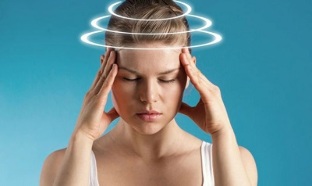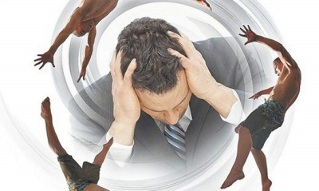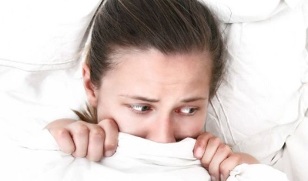
Pathologies of the spine often cause completely unexpected symptoms.
At first glance, they have nothing to do with illness. But a person has cervical osteochondrosis, and dizziness, fear, and depression can easily become part of his life as well.
For successful treatment, it is important to correctly identify the root cause of these problems.
Dizziness in osteochondrosis: causes of its appearance
Cervical osteochondrosis is especially dangerous because it interrupts the blood supply to the brain. The deformation of the discs and vertebrae can compress the vertebral artery, which provides up to a quarter of the volume of blood needed by the brain.
Dizziness is a direct consequence of a lack of oxygen in the brain. In the milder stages of the disease, it usually occurs intermittently and for a short time. The head may feel dizzy after sleeping or when there is a sudden change in body position. If the disease progresses, this condition can last for hours. It is also often accompanied by nausea, vomiting, visual impairment.
It is very important to correctly identify the cause of the problem. The head can get dizzy not only from osteochondrosis. The same symptom can be given by disorders of the heart and blood vessels, anemia and other diseases. In this case, the treatment approaches must be completely different. Often times, the misdiagnosis led people to be treated for years for hypertension or other similar illnesses instead of treating the spine.
Blood pressure and cervical osteochondrosis
In this case, cervical osteochondrosis can also cause manifestations of vegetative-vascular dystonia. The reasons also lie in the pinching of the vertebral artery, as well as muscle spasms. Intracranial pressure reacts particularly painfully to osteochondrosis.

This phenomenon can manifest itself as headaches, feeling of heaviness, tinnitus, visual impairments. The use of conventional drugs for the treatment of hypertension does not give results (or they are of short duration). Once again, the correct diagnosis is the key to successful treatment.
Increased pressure can also cause pain, so the manifestations of VSD in osteochondrosis can be very strong.
If, in addition to the neck, the thoracic region is also affected, interruptions in the work of the heart, arrhythmia and a feeling of tightness in the chest may be observed. Again, heart medications don't work.
Osteochondrosis is very dangerous because it gives symptoms similar to the manifestations of other serious diseases. Many things can be attributed to it, and the time when urgent help is needed for the heart and blood vessels may be missed.
What to do if you feel dizzy with cervical osteochondrosis
If the diagnosis has not yet been made, dizziness due to osteochondrosis may be suspected if it occurs when changing posture. Also, the neck tends to break.
Vertigo can be eliminated by maintaining normal blood circulation in the neck. You can try self-massage as a quick-acting remedy. To prevent the seizures from happening again, you will need to undergo treatment. What to do in a specific situation, the doctor will advise you.
Different medications and therapies may be required at different stages of the disease:
- A course of muscle relaxants to relax muscle spasms.
- B vitamins: also have a beneficial effect on blood circulation.
- Several massage sessions with a specialist, then regular self-massage of the neck.
- Physical therapy is essential: the movements will help to release the pinched vessels and stimulate blood flow.
Prolonged exposure to fresh air works well. You should stop smoking and limit your alcohol consumption, as these bad habits negatively affect blood circulation. And the main thing is to diagnose cervical osteochondrosis in time, and dizziness, fears and depression will not have time to develop.
Reasonable and unfounded fears in osteochondrosis
Osteochondrosis gives manifestations not only in the physical sphere, but also in the psychological one. Often this disease is accompanied by panic attacks and obsessive fears.

Its appearance has both objective and subjective reasons. Unreasonable panic can be the result of a stroke.
But even more often, fears are a consequence of other painful manifestations of osteochondrosis:
- The patient is constantly expecting attacks of pain and is afraid of them.
- There is fear of the possibility of being disabled.
- The length of treatment is terrifying with the prospect of no results.
- Some symptoms lead to the expectation of other diseases (heart attack, stroke, upset stomach).
These psychological reactions can only be avoided with the right attitude. The patient must constantly remind himself that osteochondrosis is not a prayer. Do not neglect pain relievers so as not to be afraid of pain. Family members and acquaintances of the patient must constantly demonstrate confidence in his speedy recovery and maintain a constructive attitude.
Depression as a possible result of osteochondrosis
If such "psychotherapy" is not carried out, there is a risk of depression.
This condition can have a wide range of unpleasant consequences:
- Loss of performance, chronic fatigue syndrome.
- Insomnia.
- Mental disability.
- Serious violations of self-esteem.
- Menstrual irregularities in women.
- Digestive disorders.
- Numbness of certain parts of the body.
Neglected depression can even lead to suicide attempts, so ignoring its manifestations is dangerous.
Depression occurs as a reaction to prolonged pain and discomfort. Its appearance is also favored by social problems that inevitably accompany patients with osteochondrosis.
- Feeling a missed opportunity to lead a full life.
- Prolonged "abandonment" of the labor process.
- Awareness that illness causes discomfort to loved ones.
- Feeling of helplessness, vain efforts: the disease does not go away despite the measures taken.
It is important to note that some pain relievers also have a depressive effect on the central nervous system and can lead to a depressive state. Therefore, powerful painkillers should not be abused, using them only for exacerbation. If there is no severe pain, it is better to use ointments, massages and physical therapy procedures. Family members of the patient should be aware that depression often prevents the patient from realizing his problem, so they will almost certainly have to "push" him into treatment.
Treatment of psychological problems in osteochondrosis
In the case of severe depression with many dangerous manifestations, it is often necessary to use strong antidepressants. But you should know that all these drugs have an addictive effect, and you cannot use them for a long time. As soon as the most serious manifestations are eliminated, such drugs should be abandoned.
To get rid of fears and depression, first of all, it is necessary to treat osteochondrosis itself. A set of standard measures is suitable for this: elimination of muscle spasms, chondroprotectors to strengthen cartilage tissue, exercise, physiotherapy. But at the same time it is necessary to improve the mental state of the patient.
- Regular walks and moderate physical activity are needed. Light physical activity stimulates pleasure.
- To normalize sleep, you need an orthopedic pillow or just a low stiff pillow. The bedroom should always be well ventilated.
- Others must motivate the patient to recover.
- It is necessary, as far as possible, to involve the patient in public life, family affairs and official duties. In most cases, you can find activities that don't hurt your spine. But the person will feel useful and necessary.
- In severe cases, the help of a psychologist and even a psychiatrist may be necessary. There is no need to be afraid: going to a psychiatrist does not mean losing your mind.
The main thing is to "call to order" cervical osteochondrosis, and dizziness, fear and depression will no longer be threatening. Against the background of a decrease in painful manifestations, psychological rehabilitation will be much better.
But the best thing to do is simply avoid these symptoms. It is worth starting to treat cervical osteochondrosis in time, and dizziness, fear and depression will never appear.





































